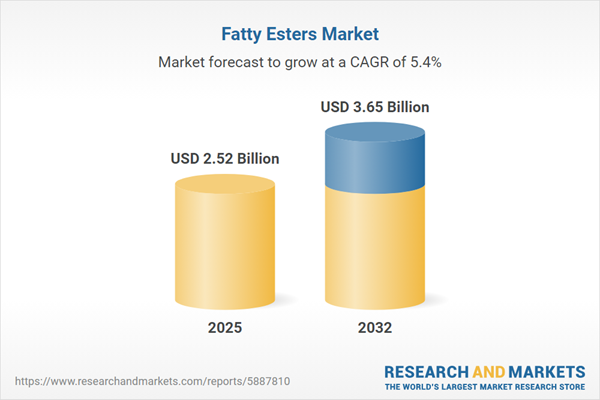Speak directly to the analyst to clarify any post sales queries you may have.
The fatty esters market is evolving swiftly as sustainability demands, regulatory shifts, and increased stakeholder scrutiny drive industry-wide transformation. Senior decision-makers are capitalizing on innovative technologies and reconfigured business models to secure growth opportunities and navigate new compliance landscapes.
Market Snapshot: Fatty Esters Market Growth Trajectory
The global fatty esters market is experiencing consistent expansion, valued at USD 2.39 billion in 2024 and set to reach USD 2.52 billion by 2025. Projections indicate a compound annual growth rate of 5.40%, with revenues anticipated to climb to USD 3.65 billion by 2032. This growth is driven by ongoing advancements in chemical manufacturing, the shift to renewable feedstocks, and increasingly stringent regulatory expectations. Industry leaders are amplifying their presence by integrating digital transformation strategies and upgrading technical operations to match the evolving demand landscape, ensuring the flexibility needed in a dynamic international market.
Scope & Segmentation: Comprehensive Fatty Esters Market Landscape
- Product Types: Methyl, butyl, ethyl, and propyl esters enable manufacturers to tailor offerings for sectors demanding specific performance attributes and compliance with strict regulatory standards.
- Applications: Fatty esters are key constituents in biodiesel, lubricants, food additives, pharmaceuticals, cosmetics, plasticizers, and solvents, shaping product safety, differentiation, and formulation versatility within regulated industries.
- Feedstock Options: Sources span animal fats, a wide range of vegetable oils including canola, palm, soybean, and sunflower, as well as recovered waste oils, supporting resilient and sustainable supply chains through reduced environmental impact and diversified resources.
- End User Industries: Automotive, industrial, food and beverage, cosmetics, and pharmaceutical sectors depend on fatty esters to fulfill durability, compliance, and performance objectives, contributing to unique product requirements in each domain.
- Chain Lengths: Long, medium, and short chain fatty esters provide adaptability in chemical structure and physical properties, facilitating optimal product design for specialized uses from high-performance lubricants to food-grade inputs.
- Regions Covered: North America, South America, Europe, Middle East, Africa, and Asia-Pacific present distinct regulatory and commercial environments, requiring tailored regional strategies to maximize market potential and ensure compliance.
- Companies Profiled: Leading firms such as Emery Oleochemicals LLC, Croda International Plc, Indorama Ventures Public Company Limited, KLK Oleo Sdn Bhd, BASF SE, Stepan Company, Wilmar International Limited, Cargill, Incorporated, The VVF Ltd., and Kerry Group plc are advancing innovation and global supply assurance.
- Key Technologies: Adoption of enzymatic biocatalysis, continuous flow processing, solvent-free production, and supercritical CO2 extraction elevates operational capabilities. Integration of digital technologies including real-time analytics, artificial intelligence, predictive maintenance, and blockchain enhances efficiency, oversight, and transparency across production and distribution chains.
Key Takeaways for Senior Decision-Makers
- Integrating diversified and renewable feedstocks strengthens supply chain resilience, addressing sector-specific risk and supporting environmental compliance.
- Transitioning to modernized production systems and agile supply chain models enables organizations to keep pace with evolving regulatory landscapes and complex global supplier networks.
- Implementing digital transformation initiatives, coupled with advanced analytics and predictive technologies, supports more proactive compliance oversight and operational responsiveness.
- Emphasizing recycled and alternative raw materials elevates sustainability credentials, aligning business practices with circular economy initiatives and improving market positioning.
- Targeted research and development in automotive and cosmetic applications presents avenues for differentiation and engagement with new customer segments.
- Forming industry alliances and cross-sector partnerships fosters adaptability, helping companies remain responsive to shifting regulations and diverse client needs while encouraging collaborative innovation.
Tariff Impact: Navigating U.S. Policy Shifts
Recent changes in U.S. tariffs affecting fatty ester feedstocks have prompted organizations to reassess procurement and logistics strategies. Increased emphasis on regional sourcing and broadening supplier partnerships is instrumental in reducing volatility. By adopting flexible procurement frameworks and proactive risk management, companies are safeguarding competitiveness as North American trade patterns adjust.
Methodology & Data Sources
This assessment is based on direct interviews with industry executives and technical specialists, rigorous peer-reviewed research, and current regulatory analysis. Data triangulation ensures that findings deliver robust, actionable insight for senior market stakeholders.
Why This Report Matters
- Guides organizations with evidence-based recommendations to enhance supply chain stability and maintain compliance amid regulatory change.
- Provides tailored pathways for digital transformation, supporting operational continuity and increased manufacturing agility to mitigate volatility.
- Clarifies key segment structures and regional trends, enabling refined strategies for go-to-market and product positioning initiatives.
Conclusion
Organizations that prioritize technology, regulatory adaptation, and sustainability are better equipped for success in the evolving fatty esters market. Innovation and cross-sector collaboration are fundamental for seizing emerging opportunities and securing long-term relevance.
Additional Product Information:
- Purchase of this report includes 1 year online access with quarterly updates.
- This report can be updated on request. Please contact our Customer Experience team using the Ask a Question widget on our website.
Table of Contents
3. Executive Summary
4. Market Overview
7. Cumulative Impact of Artificial Intelligence 2025
Companies Mentioned
The companies profiled in this Fatty Esters market report include:- Emery Oleochemicals LLC
- Croda International PLC
- Indorama Ventures Public Company Limited
- KLK Oleo Sdn Bhd
- BASF SE
- Stepan Company
- Wilmar International Limited
- Cargill, Incorporated
- The VVF Ltd.
- Kerry Group PLC
Table Information
| Report Attribute | Details |
|---|---|
| No. of Pages | 194 |
| Published | November 2025 |
| Forecast Period | 2025 - 2032 |
| Estimated Market Value ( USD | $ 2.52 Billion |
| Forecasted Market Value ( USD | $ 3.65 Billion |
| Compound Annual Growth Rate | 5.4% |
| Regions Covered | Global |
| No. of Companies Mentioned | 11 |









